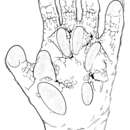en
names in breadcrumbs


Because this species is small and nocturnal, communication between individuals is likely primarily olfactory in nature. Palma (1997) reports that the olfactory and visual regions of the brain of Thylamys elegans, a closely related species, are especially well developed.
Communication Channels: visual ; tactile ; acoustic ; chemical
Perception Channels: visual ; tactile ; acoustic ; vibrations ; chemical
This species is listed as "Least Concern" by the IUCN.
IUCN Red List of Threatened Species: least concern
There are no known negative effects of Thylamys pallidior.
There are no known positive impacts of Thylamys pallidior on humans.
Thylamys pallidior acts as an important predator to many arthropod species and some small vertebrates. It is prey to several bird and medium-sized mammals, such as owls and foxes. Braun et al. (2010) list six ecto- and endoparasites associated with Thylamys pallidior.
Commensal/Parasitic Species:
Albanese et al. (2010) examined the feces of wild Thylamys pallidior individuals and found that its diet primarily consisted of arthropods. Other dietary components include leaves, fruit, and seeds. Other Thylamys species have been observed consuming small vertebrates (e.g. rodents, lizards), so it is possible that Thylamys pallidior also feeds on those prey items (Palma, 1997)
Animal Foods: insects
Plant Foods: leaves; seeds, grains, and nuts; fruit
Primary Diet: carnivore (Insectivore )
Thylamys pallidior is distributed from southern Peru to central Argentina, including Chile and western Bolivia.
Biogeographic Regions: neotropical (Native )
This species inhabits a number of different dryland habitats, including the high Andean steppe (Puna grassland), the Monte desert and dry Chaco of Argentina, and the Sechura Desert of Peru. For much of its range, it is found in high-elevation habitats of the Andes. At the southern extreme of its distribution, it can be found in lowland areas.
Range elevation: 0 to 3750 m.
Habitat Regions: temperate ; tropical ; terrestrial
Terrestrial Biomes: desert or dune ; savanna or grassland ; chaparral ; mountains
Braun et al. (2010) note an account of Thylamys pallidior from the early 20th century wherein a captured juvenile survived for 1.5 years in captivity, tripling in size over its life span.
Range lifespan
Status: captivity: 1.5 (high) years.
Like other members of its genus, Thylamys pallidior is notable for its incrassate (fattened) tail. The size of the tail varies by season in accordance with food availability. Although this species is a marsupial, females do not have a pouch. This species is tricolored, with darker dorsal fur, paler lateral fur, and a white ventral region. This species is broadly similar to other members of the Elegans Group (which includes T. elegans, T. pallidior, and T. tatei) as described by Giarla et al. (2010). Giarla et al. (2010) report head + body lengths that range from 73 to 104 mm (average 95 mm) and tail lengths that range from 97 to 118 mm long (average 109 mm). Braun et al. (2010) report body masses ranging from 13 to 39 g (average 19 g)
Range mass: 13 to 39 g.
Average mass: 19 g.
Range length: 170 to 222 mm.
Average length: 204 mm.
Other Physical Features: endothermic ; bilateral symmetry
Like other small mammals, Thylamys pallidior is likely well adapted to avoiding predators by being nocturnal and inconspicuous. This species has been noted as a prey item for two owl species.
Known Predators:
Anti-predator Adaptations: cryptic
Little is known about the mating system in Thylamys pallidior. Palma (1997) reports that two Thylamys elegans adults (a closely related species) have never been found in the same nest, suggesting that this species does not form monogamous breeding pairs.
Little is known about the general reproductive behavior of Thylamys pallidior. Anecdotal evidence from the early 20th century (reviewed in Braun et al., 2010) suggests that this species and other small opossums breed one to three times per year. Juvenile animals tend to be captured early in the calendar year, with only adult specimens being captured in the last few months of the year.
Key Reproductive Features: gonochoric/gonochoristic/dioecious (sexes separate); sexual ; viviparous
Little is known about the parental care of Thylamys pallidior. Like other Thylamys species, females lack a pouch, with exposed young clinging to the nipples.
Parental Investment: altricial ; female parental care ; pre-fertilization (Provisioning, Protecting: Female); pre-hatching/birth (Provisioning: Female, Protecting: Female); pre-weaning/fledging (Provisioning: Female, Protecting: Female)